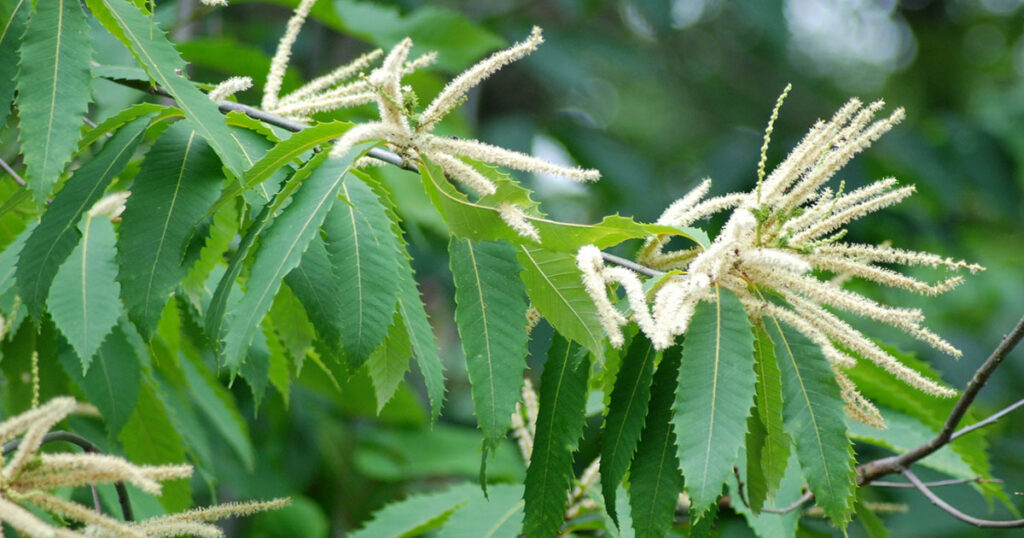
On a bright, windy day—my 38th in quarantine—my parents and I set out in search of a rare American chestnut. Dad had first heard whisper of the tree several years earlier. According to a man he’d met at a conservation event, a full-grown specimen stood in the woods behind my family’s rural Virginia home. Since then, I’d been eager to see the rumored tree for myself. But I lived in New York City. I hardly had endless afternoons to wander around the Blue Ridge Mountains looking for a tree that might or might not exist.
Then coronavirus happened. I fled south. Suddenly I had all the afternoons in the world.
The American chestnut once dominated whole forests across the eastern United States. Fast-growing, durable, and rot-resistant, chestnuts provided the “go-to” lumber for every type of project imaginable. Whole houses were made of American chestnut. So were tables, telephone poles, fiddles, fences, railroad ties, and even coffins. Consider the dependability and comfort implied by the phrase “that old chestnut,” and you’ll get some sense of the tree’s economic, ecological, and emotional centrality to American life.
All that began to change in the late 19th century, when a devastating fungus arrived via imported chestnut seeds. First identified in 1904 at what would become the Bronx Zoo, Cryphonectria parasitica went on to worm its way under the bark of American chestnuts across the country. By 1950, the fungus had claimed an estimated four billion American chestnuts, almost two for every human being then on the plant. Although other chestnut species proved resistant to the blight, the ever-loved, ever-useful American variety went effectively extinct.
Except in a few rare places.
My parents and I traipse through the woods wearing blaze-orange hats. Our backpacks are stuffed with jackets, water bottles, and gummies from the Mennonite market down the road. We follow the faint hint of a deer path uphill, past smooth beeches and proud tulip poplars. Dad points out a piece of blue quartz at my feet, but the ground is otherwise a soft pad of fallen leaves, all brown and gray and hazel.
Ever since its near-total disappearance, the American chestnut has beckoned outdoors enthusiasts like ourselves. The tree holds a special place in the cultural imagination simply by virtue of its rarity: as with all things, we want to see the chestnut precisely because it is so hard to find.
Starting to work up a faint sweat, I look out at oaks, hickories, and cherry trees. I don’t treat them with the same reverence I reserve for the American chestnut—but why not? Why must we lose something to appreciate its worth? It is a question many of us have been considering these past several months. I know I have. What I wouldn’t give to engage in ordinary activities now off-limits thanks to coronavirus: ordering a glass of wine in a busy restaurant. Checking my mail. Swiping a subway card. Lack has sharpened my hunger, my appreciation for all that once seemed unremarkable.
We keep hiking: past dizzy spirals of mountain laurel; past a beech etched with bear swipes; past a rock outcrop Mom has named “Power Point.”
After half an hour we crest the ridge, turning left onto the rugged dirt road that will lead us to within several hundred yards of the tree. Mom picks up Bud Light empties and discarded raspberry whiskey bottles as we go, tossing them into a plastic shopping bag she has brought for precisely this purpose. Soon we ascend into a cathedral of tulip poplars. Their ramrod trunks soar skyward with enviable grace and seeming confidence. A purple dusting of redbuds litters our path, as if to prepare us for the excitement of what lies ahead.
The road turns and then descends slightly. Dad and I agree: It’s time to start bushwhacking. Looking at my phone, closing in on the tree’s coordinates, I step over fallen logs and through a field of periwinkle. According to Dad’s source, we’re looking for a tree with a slight bend in its lower trunk.
And then I see it. “Look,” I shout, pointing. “I found it!”
My parents scramble over. “Damn,” says Dad, half in awe, half in disappointment. The tree is unmistakably dead, a long-delayed victim of the blight. The bark at shin level has fallen away to reveal a dull, lifeless gray; the arthritic limbs extend leaflessly into the lightly budded canopy surrounding.
Still, the tree has a haunting beauty to it, like that of an old train station or an abandoned palace. I hear the subtle creak of the trunk swaying in the wind. I circle the tree, running my fingers over its bumpy surface. The faint glisten of spider webs is visible on the bark.
“It does look like a skeleton,” says Dad, echoing a description passed down from mountain dwellers of yore. “A standing skeleton.”
A buzzard soars overhead.
Are we next? Might Homo sapiens soon go the way of the Castanea dentata? It’s an absurd question, of course, but somehow less absurd than it was a few short months ago. Dominance today does not confer dominance tomorrow—a fungus can slip under the bark, a virus can settle in the lungs. This is the shared lesson of the two pandemics. We are so much more temporary than we like to believe.
My parents and I sit in the precarious shadow of the tree, there among the bark husks and the fecund, woodsy detritus of spring. I open my backpack and pull out a few gummies. I start to eat and listen to the chirp of a chickadee, so quick, sharp, and joyous.
And then—silence.


